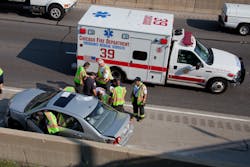EMS Field Chief Says Her Job Is Like a 'High-Wire Act'
After 25 years of working on the ambulance, I was promoted to the rank of paramedic field chief and now oversee nine ambulances. It’s a middle management job that lays somewhere in that gray area between being one of the paramedics, and being their boss. It's like a high-wire act. Fall one way and you lose authority because you are too much of a pal to the troops. Fall the other way and you lose respect because you are too dictator-like.
My skills had been honed from working over 25 years on the ambulance when I was promoted. It was fun because no matter what was thrown at me, I had the experience and skills to handle anything. There was nothing I hadn't seen or done.
The promotion
The field chief gig was a whole new ball game. Very little could be translated from my experiences on the ambulance. It was like starting over. The job is one-third administrative, one-third mandatorily dispatched runs, such as a multi-ambulance response or a fire, and one-third could be for almost anything under the sun. Anything-under-the-sun runs could include an accident involving a Chicago Fire Department (CFD) vehicle, a sick member, personnel issues or inventory problems, etc.
My first day as a field chief, I rolled out of 4-5-1’s quarters, located in downtown Chicago, better known as The Loop. As I slid behind the wheel, I made a mental check to make sure I had everything. Portable radio...check, manpower...check, my route…check, various pieces of administrative paperwork...check. I put the buggy in gear and cruised out the door on my maiden field chief voyage.
Do you know that feeling you have when you have forgotten something really important, but you can’t for the life of you think what it is? I had that. I went through my mental checklist again. I had everything, but something was missing. It came to me all at once. How about my partner? How about my ambulance? How about the fact that I had very little idea of what I was doing.
The new role
"You are so lucky. Paramedic field chief is the best job on the department," is all I heard for months after my promotion.
If I was so lucky, then why did I dislike the job so much? I didn't take to my field chief duties as seamlessly as everyone else seemed to—I was pining for the fun and camaraderie of the ambulance. The worst part was that I had to roll alone.
If you break down the word paramedic, the “para” according to the Greek meaning means side by side. The only thing by my side was an empty seat. If you have a halfway decent partner, you rely on each other for many things, from how to treat a patient to getting to the run, etc. My only partner was my GPS, not good company by any means.
The training for paramedic field chief involved a few weeks in the classroom and a couple of days of riding with another field chief—I was then thrown into the fire, so to speak.
Alone on the streets
Working by myself, I had no one to bounce ideas off of. The learning curve was not going to be steep, as we don't get very many calls. CFD ambulances can do 20 runs in a 24-hour shift. Field chiefs generally do only a few runs per shift. I had a couple of “phone a friend,” lifeline numbers of experienced field chiefs in my speed dial in case of emergency.
Little by little, the runs came and luckily no major screw-ups occurred. Each multi-ambulance response, each still and box brought a new confidence and understanding of my job. It also brought about a slow and painful death of my previous 25 years on the ambulance—I wasn't saving anyone anymore—it wasn't in my job description.
Chief Officers see the scene from a different perspective, throwing a much wider net. It’s like going from looking at something with a magnifying glass (treating one patient), to looking at it from an airplane (organizing a multi-victim response). After eight years of being a field chief, I now feel as confident as I did on the ambulance.
During every shift, I take in some ambulance runs if it sounds like it’s something interesting. My medics make fun of me for jumping in and staring an IV or intubating a patient. “Hey chief, you still got it,” they joke.
I sometimes still miss the excitement of working on a CFD ambulance—the save that made me feel like a million bucks or calming a psych patient who I was sure was going to become violent at any moment.
I take pride in my job as a chief officer in a very different way than I did as a paramedic on the ambulance. It is knowing that my crews trust me and that I am there for them no matter what problem arises.
Becoming a chief officer is the most difficult transition in our chain of command. Unlike working on the ambulance, it may take a year or more to feel comfortable in the position. It involves looking at a bigger picture of a scene, and not micro-managing, striking a balance between being a boss and being one of the guys and gals—and most importantly—never forgetting where you came from.
MARJORIE LEIGH BOMBEN has been a paramedic with the Chicago Fire Department since 1983, rising through the ranks to become paramedic field chief. She worked on CFD ambulances for 25 years. She recently authored It's Not the Trauma, It's the Drama: Stories by a Chicago Fire Department Paramedic.
